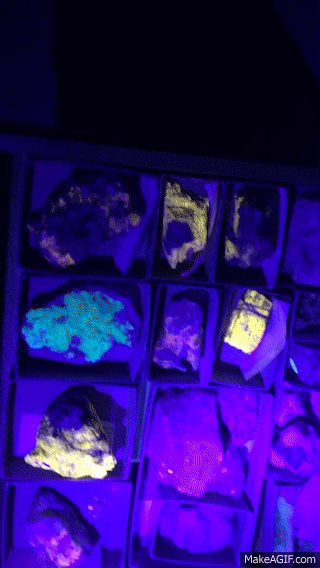EDUCATION RESOURCES:
NGSS Standards:
PS
Have you ever been to a natural history museum? Sure, they have awesome fossils, human artifacts, and taxidermied animals on display. But did you know that a big part of natural history museums is what you can't see in the exhibits? Natural history museums serve as archives, or record keepers, of the natural world. Much of their collections are stored behind the scenes.
At the Field Museum in Chicago, only one percent of their collections are on display. The rest are tucked in a labyrinth of hallways around the center of the museums' giant walls. Tumble got the opportunity to take a tour of the mineral collection, thanks to Jim Holstein, the collections manager of physical geology and meteorites.

Jim is a scientist who has worked at the Field Museum for 20 years! He studies meteorites (rocks from outer space!), but he's also responsible for 60,000 rocks, minerals, gems, and even jewelry. It's his role to handle requests from scientists who want to study a specimen - or sample - from the collection. Above, he's holding a smoky quartz!

The collections floor is full of these cabinets, separated into drawers. Pull out a drawer, and you'll find specimens in cardboard boxes, with identifying information tucked in. This card for copper (a native mineral), tells us what it is, describes how it looks, where it was found, how the museum got it, and when the label was created.

The copper kind of looks like ginger, right?
The next cabinet we looked inside had the most spectacular geode we've ever seen!

Some of the Field Museum's crystals, like this one, came from the 1893 Columbian Exposition, or World's Fair, in Chicago. So they've lived at the museum for over 120 years!

In the episode, Jim Holstein mentions how quartz can come in many different colors, This is smoky quartz, aka Fantasy Goals Quartz (we just made that name up, but doesn't it look like it could give you magical powers?).

This is quartz too!! Can you believe it? The crystals are delicate and flaky. It couldn't look more different from the smoky quartz. That's why minerals have a classification system based on chemical composition, among other characteristics. Looks can be deceiving.

Above is pyrite, or fool's gold. You'll probably find this cool, blocky mineral in your school's mineral samples. It's the most common of the sulfide minerals. They're formed in high pressure water environments.

That's graphite, which you might know from the tip of your pencil!
Okay, now it's time to turn off the lights, and check out a cabinet of fluorescing, aka glow-in-the dark minerals!

Here's how Jim explains how minerals glow:
"All visible light is on the electromagnetic spectrum. It's broken down into all the different colors you see in a rainbow. But if you go beyond the color spectrum, you have different energy levels. And when you go beyond the purple side, you have a group of spectra called ultraviolet.
So these are all different wavelengths. The close the wavelengths get to each other, the higher the energy. And what this energy does, is that it 'excites' electrons in particular elements within these minerals, called activator elements. And when electrons are excited they go to a higher energy orbit. When they drop back down they release that energy in the visible light spectrum."
Here's what that looks like.

Jim is shining a special UV light on the rocks to "excite" the electrons and make them glow. (In case you're wondering, here's what the "cheesecake" colored mineral looks like, pre-glow.)

What about our favorite glowing mineral, apatite?
We're at the end of our tour. Hope you enjoyed it! Don't worry, we'll turn the lights back on! Are you hooked on minerals yet? There's so much more to know!
To hear more from Jim Holstein, who gives great tours, check out this video about meteorites on the Brain Scoop!






